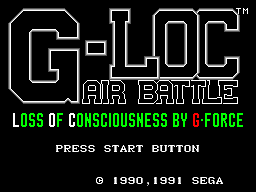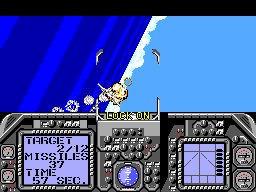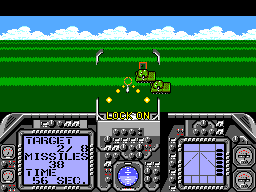
| Review Information | |||
| Reviewer Name: | Tony Wilkins | ||
| Game Difficulty: | Medium | ||
| Difficulty Options: | True | ||
| Game Information | |||
| Full Title: | G-LOC: Air Battle | ||
| Year Released: | 1991 | ||
| Game Type: | Shooting | ||
| Max Players: | 1 | ||
| Introduction |
   |
||||||||||||||||||||||||||||||||||||
| A terrorist group have "confiscated" large numbers of military hardware from the government and it is up to you to return them or destroy them trying. More than likely it will be the latter. At your disposal is the mighty F-14 Tomcat (not an F-16 like on the box). This is another one of Sega's efforts to bring the arcade in to the home. The original arcade game was released in 1990 and as well as stand-up and sit-down cabinets, there was also a full 360 degree rotating cabinet. Michael Jackson liked it so much he bought his very own one for his home! G-LOC has a somewhat forced marriage to Sega's more well known Afterburner franchise. It was advertised as a spiritual successor to Afterburner II although it was very much its own game but when it got its Mega CD port it found itself slapped with the name Afterburner III. | |||||||||||||||||||||||||||||||||||||
| Gameplay | |||||||||||||||||||||||||||||||||||||
| The game makes an admirable effort to replicate what you see in the arcade (minus the rotating chair which would be cool). They could have simply made it an Afterburner-clone putting you in the third person but instead the game provides you with a cockpit display that includes weapon and target information as well as the time remaining just like in the arcade. A working artificial horizon was a really nice touch. With each mission you are given an objective which consists of a minimum number of enemies you have to obliterate. Enemies consist of air units such as enemy F-14s and ground units such as tanks and ships. As you progress through the game the number of targets you have to send to hell increases putting a strain on your ammunition and time. Between missions you can use your credits to either buy more weapons or more time. If you are confident of your accuracy then more time is the best option but having to fall back on your guns because you have filled the skies with missiles that only hit the odd Seagull rather than a plane is infuriating. If this is you then more ammo maybe the answer. This adds an interesting concept of strategy to the game making you identify your own strengths and weaknesses and then working around them as you progress. During some air-to-air missions you may find yourself in the sights of an enemy "ace". When this happens you actually have the enemy's viewpoint with your plane ahead of him trying to throw him off. The only other variation to the game are the boss battles which sees you pitted against a single enemy with multiple hit points that just spits out missile after missile at you. | |||||||||||||||||||||||||||||||||||||
| Graphics | |||||||||||||||||||||||||||||||||||||
| This game has a fairly decent look to it. The cockpit is nice to look at even if its primary role is to limit the actual gameplay screen to ease the burden on the Master System's processor. On the downside the frame rate is noticeably a little low which gives things a slightly jerky look but its hardly headache-inducing like Space Harrier 3D. |
|||||||||||||||||||||||||||||||||||||
| Sound & Music | |||||||||||||||||||||||||||||||||||||
| The music is very high pitched in tone and complements the gameplay well enough. Unfortunately, its hardly memorable and I found myself watching gameplay footage on YouTube to recall it when writing this review. The sound effects are the usual Master System distortions for explosions and weapons firing. | |||||||||||||||||||||||||||||||||||||
| Controls | |||||||||||||||||||||||||||||||||||||
| OK - this is often the biggest criticism of G-LOC on the Master System. Like Afterburner you have very little control of your direction of flight. This is not a 3D environment. Instead you are racing along a set path where enemies appear and your controls are limited to flying within that pathway. This makes the game feel restrictive and stiff. What little control you do have works well enough and once you learn how to avoid the missiles you will blast your way through the game.
Like most flight games you have a choice of reversing the controls so up on the D-pad pushes you down and vice-versa. |
|||||||||||||||||||||||||||||||||||||
| Replay Value |
|
||||||||||||||||||||||||||||||||||||
| This is not an overly addictive game. It is a good one to play for half an hour on occasion but its hardly one that you will want to put in your Master System at least once during every session where you pick up the rectangular controller. | |||||||||||||||||||||||||||||||||||||
| Conclusion | |||||||||||||||||||||||||||||||||||||
| I've had a long history with G-LOC having played both the arcade and the Mega Drive versions back in the day. In the present I also have the aforementioned Afterburner III-titled Mega CD port.
The Master System version gets a lot of negative comments online but I think you have to remember that this is a flight-shooter on an 8-bit console and in that context it isn't all that bad. The control scheme more than anything else will put some people off but if you can get the feel for it then there is some fun to be found in this title. It is a decent effort at an arcade port for the Master System and is more successful than some earlier efforts. Give it a try. |
|||||||||||||||||||||||||||||||||||||
Copyright © 2025 Sega8bit. All Rights Reserved.







